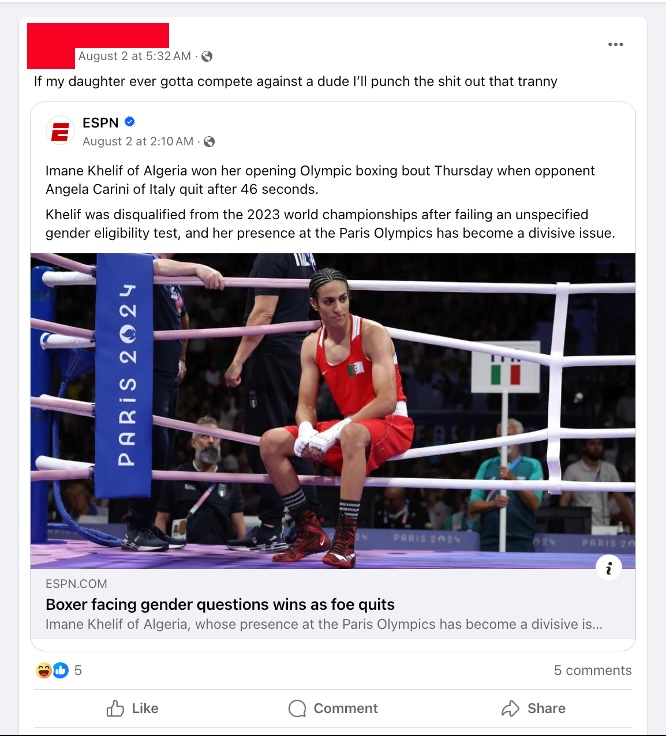Social Media erupted after an Olympic Boxing match between Algeria’s Imane Khelif and Italy’s Angela Carini. Carini quit the fight after 46 seconds, and refused to shake Khelif’s hand when the winner was announced.
Following the fight, prominent figures and news outlets have accused Khelif of being a male or trans, and criticised her participation in women’s boxing. Khelief has since gone on to win the gold medal.
Much is still unknown about this story, but here are some facts. Khelif was raised a girl in Algeria, where changing one’s name or having gender affirming care is illegal. Khelif had a long history of competing in international women’s boxing events before being told in 2023 that she had failed the International Boxing Association’s (IBA) eligibility requirements for participation in female competition. At a recent press conference, the IBA claimed that tests revealed Khelif had XY chromosomes. These results were made available to the International Olympics Committee (IOC) prior to the 2024 games, but an IOC spokesperson has described the IBA’s tests as “so flawed that it is impossible to engage with”. The validity of these tests, as well as the veracity of the IBA as an organisation, remain in dispute.
Controversy of this kind is nothing new. Mokgadi Caster Semenya is a soccer player turned middle-distance runner from South Africa. Her career was brought under the spotlight in 2009 during the World Championships in Athletics when World Athletics (then International Amateur Athletic Federation) requested she take a sex verification test. The test revealed that Caster had a developmental disorder and male genes. The official reason for requesting the test was her dramatic improvements over a period of 9 months. Usually, similar improvements would have resulted in a drug test, but a decision to test her sex instead was made solely based on her appearance. The test request was made 3 hours before her 800m race in the World Championships marring her victory in the earlier 1500m and her subsequent victory in the 800m. Results of the test were leaked to the media resulting in a great deal of public discussion and media coverage and eventually leading to rule changes affecting allowable hormone levels in female competitors.
Online Transphobia
Regardless of the lack of available information, the recent Imane Khelif situation has caused a firestorm online. Many of the posts involve the use of pre-existing transphobic slurs and stereotypes, which are mistakenly directed towards Khelif. While Khelif is not trans, these posts are still transphobic. If someone hurls racist abuse at someone they mistakenly believe to be of a certain race, they are still being racist. Likewise, when social media users attack Khelif because they perceive her to be trans, these users are being transphobic. The intent is to attack someone on the basis of protected characteristics, and so these posts can be considered hate-speech even though their target is actually not part of the protected group.
The following post from X (formerly Twitter) describes Khelif as a “troon freakshow” and recommends she is put “back in the closet”. The word “troon” is a transphobic slur, and the use of the work “freakshow” intends to dehumanise trans people. The suggestion that trans people are “put back in the closet” is an attempt to exclude trans people from wider society.

The following post, from X, describes Khelif as an “abomination”, which feeds into transphobic narratives about trans people being unnatural or against god’s will. The post continues to claim that she is a “by-product of communists thrusting down Pseudo liberal Radical left ideas in OUR rational traditional normal minds”. This denies the reality of trans women’s identity by claiming that they have only transitioned because of liberal propaganda.

The following post from Gab, which describes Khelif as a “sick fuck shemale”, uses transphobic slurs. The word “shemale” is a slur that is designed to obscure trans women’s identities.

The following Facebook user posts an image of Khelif with text that reads “when you’re a sorry excuse for a man who needs to pretend you’re a woman so you can beat on women to be a winner”. The user then writes that “This Tranny pandering bullshit needs to be ended!”. As well as using the transphobic slur “Tranny”, his user also implies that trans women “pretend” to be women, thus denying the reality of trans women’s gender identity and portraying them as a threat to cis women.

Inciting Violence
Because the controversy was sparked by a boxing event, many commentators reacted by inciting violence against trans women, in response to what they mistakenly perceived to be a trans woman punching a cis woman.
The following post from Facebook says that “a real man should beat the shit out of” a trans woman if the “tranny” fights in a woman’s sport. As well as using the transphobic slur “tranny”, this post encourages violence towards trans women.

Similarly, this next Facebook user claims that, if their daughter ever had to compete against “a dude”, they will “punch the shit out of that tranny”.

We see a similar implication in the following Youtube comment, in response to a video about Khelif. The user recommends that what would “ideally happen” is that a group of “mma/ boxing dudes” would approach Khelif for some “serious game”. Clearly, this user is glorifying violence towards athletes that they perceive to be trans.

Conclusion
Before the facts of the situation were clear, prominent figures and media outlets were quick to accuse Imane Khelif of being trans. In response to these accusations, social media users all over the world were equally quick to adopt this narrative and use it as an opportunity for transphobic hate-speech. This is a prime example of the way that online misinformation directly feeds into and encourages pre-existing prejudices, and provides a medium for social media users to express those prejudices en masse. It also illustrates the way in which online hate-speech is reactive to and encouraged by real-world events.
